
Happy Stress Awareness Month!
HIGHLAND PARK — Everyone who steps inside the Touching Earth Mindfulness Learning Center is asked to take off their shoes, a gesture signifying one’s preoccupations were left outside to fully experience the present.
The ranch-style house’s sparsely-appointed living room also contributes to the relaxing vibe.
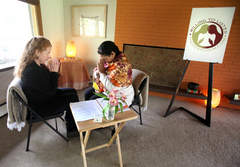
PHOTO: Elesa Commerse (right) and Ceily Levy (left), who co-direct the Touching Earth Mindfulness Learning Center in Highland Park, take part in a deep study class at the center. | Buzz Orr~Sun-Times Media
The secret is out: meditation is good for you. A few minutes of quiet contemplation every day can reduce stress levels, ease anxiety, increase your focus and concentration, and lower your heart rate and your blood pressure. If you’re looking for an oasis to learn meditation, Touching Earth is a great place to go and get your stillness on. Touching Earth is a mindfulness education center dedicated to meditation, contemplation, yoga, and self-discovery. Located in Highland Park, Touching Earth sits among a woodland where you can enjoy various plants and flowers, and where it’s common to witness deer, hawk and other animals enjoying nature. Meditation Teacher Elesa Commerce guides students through non-denominational, non-sectarian practices and classes; there is no dogma, only peace and stillness. If you’re looking for a day-drip escape or a class where you can power down, tune into yourself, and learn some meditation skills, try one of her workshops at Touching Earth.
Taking time away for a retreat is a great way to get started with meditation, but it also meets you where you are, right in the middle of messy, busy life.
Taking time away for a retreat is a great way to get started with meditation, but it also meets you where you are, right in the middle of messy, busy life. In a world where information travels at a dizzying speed, where we’re more connected to the information superhighway than we sometimes want to be, it can be difficult for us to know the difference between real human connection and the digital facsimile. “The ability to be compassionate, the ability to truly see another person, and to hear them, and to hold sacred space for them: all of those things are important. No computer, no iPhone, no nothing—no matter how smart and sophisticated it is—can make up for relating person to person,” Elesa says. “Because we’re being asked to do so much now, our nervous systems are terribly overwhelmed. Part of what happens when you meditate is you have the ability to enter into a different relationship with time. When you enter into a true place of meditation, things start to slow down and you begin to experience a concept of time in a totally different way.” In this way, meditation provides a rest for our weary and overstimulated minds, so that we can return refreshed to our daily lives, and connect more fully with our community.
Meditation provides a rest for our weary and overstimulated minds, so that we can return refreshed to our daily lives, and connect more fully with our community.
The truth is, we’re meditating all the time, and we don’t even know it. “If we take the definition of meditation as effortless concentration, we all can relate to those moments when we truly lose track of time,” Elesa says, whether it’s running along the lake, dancing, having a chat with your bestie, or even if it’s your weekly episode of Scandal or Homeland. At home, says Elesa, pick the same place to meditate every time. “If it’s the same place, we can build up the vibration in that place. You have the ability to build up a vibration in a place where you meditate if you do it regularly. Once you spend time there, meditating over and over again, then when you pass that place, when you enter that place, it will begin to lift you up, and help you access that neuronal pathway of peace that you’ve been cultivating.”
Elesa’s wisdom and patience are a soothing balm for a hectic life. At Touching Earth, she offers classes and workshops designed to help you get in touch with your own peace and stillness, to pursue a sweeter, easier and more balanced existence.
Q: How did you start meditating?
E: I was fortunate to have a mother who meditated. I grew up in a household where it was very common for us to sit and be quiet. My mother used to take me to [meditation] classes with her as far back as I can remember.
One of my favorite places to hang out is bookstores. I was in a bookstore one day in the late Seventies. I came across this title by this guy, and I couldn’t even pronounce his name. I had never heard of him before, but it really called to me. I took it off the shelf and looked at it, and on the back cover it said that Martin Luther King had nominated him for the Nobel Peace Prize. I’ve studied the work of Martin Luther King for decades, he’s one of my heroes, so I thought, “If Martin Luther King nominated him, I need to know who this guy is, even though I can’t pronounce his name.” That was The Miracle of Mindfulness [by Thich Nhat Hanh.] I was so taken with the work that I sought him out and started going on retreat with small numbers of people.
Q: Tell us about Touching Earth.
Elesa: It’s a partnership between Ceily Levy and myself. Ceily Levy is a gifted asana teacher and meditation teacher, and I’ve known her for several years. We started having conversations a few years ago about a different kind of place for people to study in. Back in the day, the way a teacher was most
“What we need in the West is to have a practice that doesn’t just exist on a cute meditation cushion or a slick little yoga mat; but rather, has a kind of flexibility and strength and durability to roll with whatever shows up in life.”
helpful to you as a student was in their relationship with you. You came to live with the teacher, in fact. Over time, the teacher came to know the good, the bad, all of it, about you; and so did you, about the teacher, rather than having some sort of pedestal relationship or something like that, you had something much more fibrously real.
What we need in the West is to have a practice that doesn’t just exist on a cute meditation cushion or a slick little yoga mat; but rather, has a kind of flexibility and strength and durability to roll with whatever shows up in life. That’s why this place is called Touching Earth, [taking] inspiration from my teacher, Thich Nhat Hanh, who says so beautifully and clearly, “Thankfully we’re not asked to walk on water.” What we’re asked to do is walk on the earth. Can we walk on the earth and with what qualities can we walk on the earth? Can we walk mindfully, lovingly, with forgiveness and kindness and compassion and generosity and sweetness and stewardship, on the earth?
So we wanted to be in a house, because you live somewhere. We do mindful eating classes, and mindful speaking mindful, listening, yoga, in a house, so you can see how this can be more easily integrated into your own house. And it’s not a fancy house; it’s a very modest house. You don’t need anything, really, but yourself, which you have wherever you go. You need your breath; your breath is with you wherever you go. We don’t need all this elaborate stuff; you don’t have to buy anything. That peace and joy, it’s in you. You were born with it, it’s in you all the time, it’s always available to you: it’s us. We must learn how to make ourselves available to it.
Q: Why is having a meditation practice so useful in our world? Why do we need to meditate?
E: I think what’s happening is we’re diluting our humanity. We’re accepting poor, cheap substitutes for our humanity. If we get too used to those, then we can lose contact with those things which by their very nature define us as human beings: the ability to be compassionate, to truly see another person and to hear them, and to hold sacred space for them. No computer, no iPhone, no PDA, no matter how smart and sophisticated it is, can do that; that must happen person-to-person. We’re becoming so comfortable interacting with each other through things. We’re energetic beings that carry a vibration, and that gets pretty impeded when that has to travel through electronics.
“You get a little bit of a pause and it might only be a nanosecond, a couple of nanoseconds, but oh, boy, for the body and for the nervous system, that’s serene.”
Part of what happens when you meditate is you have the ability to enter into a different relationship with time. Normally, we’re very linearly oriented—we have a watch we have a clock, we know what time it is, we have a certain amount of time to do this or that: when you enter into a true place of meditation, where there is a stilling of the body, a quieting of the mind, you begin to experience the concept of time in a totally different way.
Q: What are some of the physiological benefits of meditation?
E: Your heart rate slows down, your blood pressure drops, the body temperature drops a little bit. The chemistry in the body changes, in large part because every single thought we have creates a chemical reaction in the body. Usually our thoughts are coming really quickly. But when you start to meditate, often there’s a slowing down. Rarely ever a stoppage—the mind thinks, it’s a thinking tool, it’s going to feed you thoughts—but it can slow down to a pace where you start to feel a pace between the thoughts. You get a little bit of a pause and it might only be a nanosecond, a couple of nanoseconds, but oh, boy, for the body and for the nervous system, that’s serene.
Q: If you were going to give five tips to someone who wants to build a meditation practice, what would you suggest?
E: Pick a place where you’re going to do this, and ideally, it’s the same place. If it’s the same place, we can build up the vibration in that place. When we walk into a mosque or synagogue, we get a certain type of feeling. When we walk into a funeral home, we get a certain type of feeling. When we walk into our home, we get a certain type of feeling: all that’s vibration. You have the ability to build up a vibration in a place where you meditate if you do it regularly. That will help you entrain as soon as you step into that space. Once you spend time there, meditating over and over again, then when you pass that place, when you enter that place, it will automatically begin to lift you up, and help you access that neuronal pathway of peace that you’ve been cultivating in your brain. So same time, same place: a clean and quiet place where you won’t be disturbed for some time.
I encourage people who are just starting—the science, this is from Dr. Ritchie Davidson, one of the leading neuroscientists in the whole country—eight minutes for a minimum. Eight minutes, if you really do that for eight minutes, you’ve done some good for your brain and your mind and your body. Set a timer in the beginning, set it for eight minutes, sit down, be with yourself, and what are you doing? That’s really important. A lot of people say, “I’m meditating,” and I say, “what happens?”, and it turns out it was some of the best thinking they did, or problem solving or strategizing, or cussing somebody out—that’s not what I’m talking about when I say meditating.
“A lot of people say, ‘I’m meditating,’ and I say, ‘what happens?’, and it turns out it was some of the best thinking they did, or problem solving or strategizing, or cussing somebody out—that’s not what I’m talking about when I say meditating.”
Sit in a way that supports the natural curvature of the spine. We’re sending energy up the spine which is connected to the brainstem, which is connected to the brain. So we do pay attention to how we sit when we meditate.
What you’re doing is you’re welcoming whatever shows up on the screen of your mind with acceptance. You’ve made a decision for the next eight minutes; I’m not going to run away. Thoughts are going to come to your mind, that’s what the mind does. What’s important, and what we’re training in, it’s just like when we get the new puppy, and we train the puppy to sit and to stay, we have to train the mind to stay as well. An average thought or feeling or emotion lasts between two and three seconds; we don’t have to get swept away by that. All we have to do is hold our seat and welcome whatever’s there, but not get involved in it. By doing that we’re cultivating a sense of authentic friendship with ourselves.
We’re not judging it, everything is fair game; we’re just realizing that the mind, your mind, is just like the sky. It can hold storm clouds, it can hold sun, the moon, stars, rain, snow, sleet, hail, and still, the sky. It’s still vast and blue—it doesn’t change colors forever. It may get dark or light, but it always comes back to blue—so it is with your mind. We can only know that through experience, but once we get to know that through experience, we can step into our lives and be with our lives as they evolve and show up so much beyond our control, without being a continuous chain of reaction.
A few other meditation tips from Elesa to remember:
· Take care that your clothes aren’t too binding or restricting around your chest and ribcage. You want your breath to come and go freely, so dress for comfort and warmth.
· If you need to sit in a chair in order to have a balanced spine, do so. There are no awards or brownie points for busting out your full lotus here. If you choose to sit on the floor, consider taking a bolster or pillow under your hips to lift them up. So few of us have hips open enough to make sitting cross-legged accessible for more than a few moments. Lifting your hips makes this more available.
· Relax your jaw, your fingers and hands. Your nervous system won’t fully relax when your jaw is clenched or when your hands are gripping. Loose jaw, hands facing up or down loose, in your lap.
· Finally, be gentle with yourself. Remember, the point isn’t to stop thinking; it’s to witness the movement of your mind with neutral observation, not with judgment. Let that inner voice be sweet as it guides you to come back to your breath and to release your thoughts.
Ready to put Elesa’s tips to work? Settle in and listen up to a guided meditation practice she recorded exclusively for The Urbaness.
By Barabra Brotman

Happy Stress Awareness Month!
By Julie Deardorff
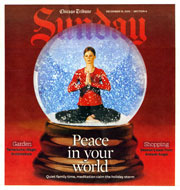 Meditation is a brain-boosting, stress-busting activity that is now embraced by everyone from the U.S. military to corporate executives. And if you’re living a busy, hectic life — and can’t fathom finding time to sit cross-legged in a quiet room — you’re an ideal candidate too.
Meditation is a brain-boosting, stress-busting activity that is now embraced by everyone from the U.S. military to corporate executives. And if you’re living a busy, hectic life — and can’t fathom finding time to sit cross-legged in a quiet room — you’re an ideal candidate too.
“If you don’t have 30 minutes to meditate, you probably need an hour,” said Tamara Gerlach, a San Francisco-based meditation student and teacher. “The people who race through their life are usually the ones who could use some focus and serenity.”
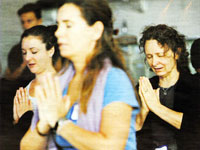 Your mind is a muscle you can train; meditation is the tool used to focus it or quiet it down. Every day thousands of thoughts zip through our heads, something Gerlach likens to a jar of dirty water: Keep shaking up the jar — or your head — and it will remain clouded. But “if we set the jar down, letting the dirt particles settle to the bottom, it leaves clarity at the top,” she said.
Your mind is a muscle you can train; meditation is the tool used to focus it or quiet it down. Every day thousands of thoughts zip through our heads, something Gerlach likens to a jar of dirty water: Keep shaking up the jar — or your head — and it will remain clouded. But “if we set the jar down, letting the dirt particles settle to the bottom, it leaves clarity at the top,” she said.
Meditation will not stop your thoughts. It will not empty your mind. Instead, proponents say, it teaches you how to replace the mental chatter in your head with stillness. This ability helps us live more consciously in the present moment.
 “Through more mindful attention, we can make wise choices,” said Joseph Goldstein, who has been leading meditation retreats worldwide since 1974 and co-founded the Insight Meditation Society. “As the Vietnamese meditation master Thich Nhat Hanh remarked, ‘Happiness is available. Please help yourselves to it.'”
“Through more mindful attention, we can make wise choices,” said Joseph Goldstein, who has been leading meditation retreats worldwide since 1974 and co-founded the Insight Meditation Society. “As the Vietnamese meditation master Thich Nhat Hanh remarked, ‘Happiness is available. Please help yourselves to it.'”
Still confused? Take a long, slow, deep belly breath and read on.
Q What is meditation, exactly?
A It’s the “art and practice of being present for your life,” said meditation teacher Elesa Commerse. The key words here are “art and practice.” Meditation requires effort and an ocean of patience, especially in the beginning. One of the biggest obstacles for beginners is that they get bored or expect Dalai Lama-like results overnight. Meditation can be relaxing, but relaxing isn’t meditation. Meditation is sitting with a purpose.
Q How does meditation work?
A There are many forms, but all involve focusing on a single stimulus, such as your breath, a particular word, or an image. Get your body in a comfortable position. When random thoughts barge into your head, label it as “a thought” and bring your attention back to your chosen stimulus, such as your breath. “It’s like training a puppy,” Jack Kornfield said in “Meditation for Beginners.” “You say ‘stay’ but after a few breaths, the puppy wanders away. You go back and gently pick it up and bring it back.” Kornfield says the practice of learning how to sit still and become mindful is one of the most important forms of meditation.
Q Who can benefit from meditation?
A Anyone who feels stressed, tired, overburdened, has a chronic injury or illness or who doesn’t want to miss out on their life. “Meditation is a way to plug people back into the deepest part of who they are,” said executive meditation coach Mark Thornton. “It will reconnect you to parts of yourself you’ve forgotten about or lost.” Meditation is increasingly being used in the health care field; Doctors treat stress-related illnesses using a meditation technique called mindfulness-based stress reduction, created by meditation teacher Jon Kabat-Zinn.
Q When should I meditate?
A Whenever you can; when you wake up, in the shower, during your morning commute, or during a board meeting. Once chief operating officer for JP Morgan, Thornton found that taking micro-meditation breaks while moving during the day could be just as profound as going on a retreat. “I thought meditation was something you did on your own; in fact it can be an integral part of the day,” he said. Constantly interrupting the mind to make a stillness connection can “interrupt suffering and create peace,” said Thornton, author of “Meditation in a New York Minute.”
Q Can I meditate while I ride a bike or run?
A It’s possible to practice mindfulness in any activity, said Goldstein. “It means paying attention to what we’re doing, rather than having our minds wander.”
Q How do I fight boredom?
A Actually, boredom is a sign that meditation is working. “It means you’re learning to shift your attention away from your mind which wants complex puzzles to solve,” said Thornton. If you’re bored, you may have lost sight that every moment in life is unique, Commerse said. “When you’re in the present moment, “every leaf, blade of grass, brush of wind, bird song, baby’s cry, every everything becomes magical, alive, discoverable and infused with the ability to transform your life,” she said.
jdeardorff@tribune.com
You can use meditation techniques wherever you are, including the shower, said corporate meditation coach Mark Thornton.
Finding Your Way: Expert Help in Navigating The Breast Cancer Journey Elesa Commerse www.foreverwhole.org
Reviewed by Debi Buzil
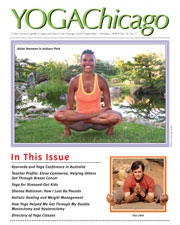 Elesa Commerse is making a difference in people’s lives. I know this as fact, for she has made quite an impact upon mine. After I was diagnosed with breast cancer in 2008, Elesa gave me a copy of Finding Your Way: Expert Help in Navigating The Breast Cancer Journey. I felt that I had found a comrade traveling these uncharted waters, often frightening and unknown. I experienced the crazy twist and turns the mind and body can take. Elesa’s wise work and words lessened the suffering, bringing peace to my world, which often felt out of control. Elesa is a nationally know meditation teacher and breast cancer survivor. Through her caring words and generosity of spirit, she has become my beacon of light.
Elesa Commerse is making a difference in people’s lives. I know this as fact, for she has made quite an impact upon mine. After I was diagnosed with breast cancer in 2008, Elesa gave me a copy of Finding Your Way: Expert Help in Navigating The Breast Cancer Journey. I felt that I had found a comrade traveling these uncharted waters, often frightening and unknown. I experienced the crazy twist and turns the mind and body can take. Elesa’s wise work and words lessened the suffering, bringing peace to my world, which often felt out of control. Elesa is a nationally know meditation teacher and breast cancer survivor. Through her caring words and generosity of spirit, she has become my beacon of light.
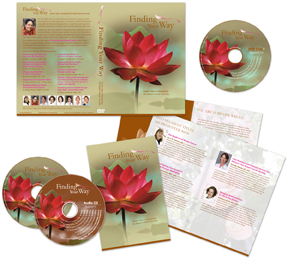 Finding Your Way is a comprehensive 2-DVD set that includes more than eight hours of programming, almost half of which focuses on hands-on practices of movement, meditation and yoga. There are nine featured presenters, including Elesa’s meditation course and guided Yoga Nidra ( Yoga Nidra is on audio CD). Topics explored include the medicine of breast cancer, nutrition and lifestyle, acupuncture for symptom relief, physical therapy, lymphodema, movement and gentle yoga. Each segment features a specialist who is at the top of her game: Dr. Nora Hansen, the director of the Lynne Sage Breast Center at Northwestern Hospital; the beaming yogini, Phoenix Rising yoga therapist and holistic health nurse Sudha Carolyn Lundeen; and others, as well as truly inspiring, wonderful women who share their breast cancer journeys (in Spanish and English).
Finding Your Way is a comprehensive 2-DVD set that includes more than eight hours of programming, almost half of which focuses on hands-on practices of movement, meditation and yoga. There are nine featured presenters, including Elesa’s meditation course and guided Yoga Nidra ( Yoga Nidra is on audio CD). Topics explored include the medicine of breast cancer, nutrition and lifestyle, acupuncture for symptom relief, physical therapy, lymphodema, movement and gentle yoga. Each segment features a specialist who is at the top of her game: Dr. Nora Hansen, the director of the Lynne Sage Breast Center at Northwestern Hospital; the beaming yogini, Phoenix Rising yoga therapist and holistic health nurse Sudha Carolyn Lundeen; and others, as well as truly inspiring, wonderful women who share their breast cancer journeys (in Spanish and English).
Elesa lost her mother, Evelyn Winslow, to breast cancer after an eight-year battle. Evelyn was not only a mother (a big enough job, if I may say so myself) but also a teacher and friend. Finding Your Way is dedicated to her. Elesa’s grandmother, at 100 years of age, is a breast cancer survivor! In a similar vein, my “Bubbe” is 92 years old and was diagnosed and treated for breast cancer more than 50 years ago. She is vibrant and healthy, a jazz pianist and a good cook to boot. Sadly, her daughter (my Aunt Cheryl) passed from the same disease at 41 years old in the 1980s. Breast cancer is no longer a death sentence, but it is a mixed bag. Today, with early detection and better treatments, it is manageable. So here’s where I ask you, dear reader, to take care of your health: do monthly self-exams, and schedule mammograms when it’s appropriate. And men, please do your screenings as well!
As I experience life, there are markers that have been transformative to me: birth, loss, marriage, my children’s milestones, anniversaries, retreat and travel. Now I have the cancer marker: life before cancer and life after the “little c” diagnosis. Things have changed. I know deeply that we are more than just this body. Finding Your Way solidifies the wholeness inherent in all of us. It is uplifting and realistic and acknowledges medical facts with dignity and compassion. Elesa lets us know that a diagnosis is simply that. And that all of us are “Forever Whole.”
Elesa has set up an amazing way to circulate her knowledge of the cancer trip. Through the generosity of the Illinois Department of Public Health, Office of Women’s Health through Ticket for the Cure Funds, The Colonel Stanley R. McNeil Foundation and private donors, thousands of copies of Finding Your Way have been given away free to under-resourced women. And for each copy sold, another copy makes its way into someone recently diagnosed with breast cancer. The power in this endeavor is stunning.
I am at the tail end of the intense part of my personal journey. Last night I lay awake, unable to sleep. Then, I hear a voice guiding me into a wellspring of calm, a transformative and restorative place of rest. I enumerate the points of my body. I practice alternate nostril breathing. This is Yoga Nidra , the last gift of the Finding Your Way series. Elesa’s gentle, firm guidance lessens my anxiety. I, in turn, hope to make a difference in someone’s life, to lessen their suffering and offer guidance in some small way to walk the path with grace and equanimity. Thank you, Elesa Commerse, for helping us all find our way.
This article is dedicated to yoga teacher Barbara Becker, who transitioned as these words were written. She had breast cancer.
……..
Debi Winston-Buzil leads the kirtan group Devi 2000. She firmly believes that you’ve got to get up to get down, sitting around is not an option, and has blogged about her cancer journey under the same name. http://debi-youvegottogetuptogetdown.blogspot.com/
She sees herself beyond the label as a “survivor,” but as one who thrives, enjoying all that life has to offer.
by Sharon Steffensen
Of all the things Elesa Commerse is–a yogi, certified meditation teacher, certified Himalayan singing bowl practitioner, MBA graduate, nature photographer, cancer survivor, producer of several CDs on mantras and meditation, and most recently producer of a DVD/CD program for those with breast cancer–she is most proud to be the daughter of Evelyn Winslow, who was her mentor, her guru and her inspiration. Elesa’s multi-faceted journey has yielded many life lessons. Prominent among these is a profound appreciation of the transformative power of meditation, which she defines as “the art and practice of being present for your life.”
Elesa’s interest in spirituality and nature began in her early childhood. Both of her parents were interested in philosophy, and their friends often met at their home to discuss P.D. Ouspensky, J. Krishnamurti, Alan Watts and other philosophers. Her father was a musician and artist who earned a living as a graphic artist. Evelyn was trained as a concert pianist and as a teacher, but she chose to be a stay-at-home mom for her two daughters. Money was scarce, so the family often spent leisure time going out into nature to “be quiet and release our cares and concerns,” says Elesa.
Evelyn was a meditator, and she was also psychic. I n the 1960s she took Elesa to the Psychic Research Foundation on Wabash Street in downtown Chicago, where classes were conducted on astrology, tarot, healing, astral travel and other metaphysical subjects. Elesa was the only child there, but from these early experiences, Elesa learned that human beings are “so much more than the body and mind.”
Growing up in what Elesa calls “the age where formal education was perceived as the ultimate ticket to freedom,” Elesa (a Phi Beta Kappa) graduated magna cum laude from Smith College with a degree in psychology. Being fascinated by the human mind, she pursued a Ph.D. in psychology right after undergraduate school and went on to earn an MBA in Marketing and Entrepreneurial Management from the Wharton School of the University of Pennsylvania. She also studied Japanese garden design at the Kyoto College of Art and Design, in Kyoto, Japan.
After graduation from business school, Elesa went to work for Procter & Gamble in Cincinnati. Around that time her mother was diagnosed with breast cancer, and Elesa returned home to Chicago. “My dad had a small publishing company and he wanted me to manage the business,” says Elesa. “I wanted to honor him by doing this [but] I realized it just wasn’t my calling. I had to let him know gently that I loved him, but that it was best for me to follow another path. Once he realized what that path was, he understood and fully supported my decision.”
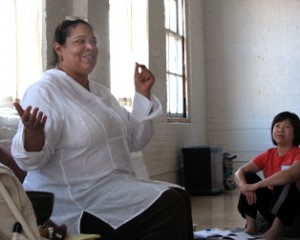 Elesa started her own business as a marketing and corporate communications consultant–at first to large companies and then to small nonprofit agencies. She focused on marketing and fundraising to help strengthen community-based organizations that served highly under-resourced populations, primarily on the south side of Chicago. While the shift was good for her, she still felt an unanswered calling. “It’s one of the things I come back to in my teachings with students,” she says. “It’s like Holocaust survivor Elie Wiesel says, ‘The only thing we are going to be asked when we die is, “Why didn’t you become you?”‘ We have so many pressures to be other than who we are. To find your way in the world and be authentic takes tremendous courage.”
Elesa started her own business as a marketing and corporate communications consultant–at first to large companies and then to small nonprofit agencies. She focused on marketing and fundraising to help strengthen community-based organizations that served highly under-resourced populations, primarily on the south side of Chicago. While the shift was good for her, she still felt an unanswered calling. “It’s one of the things I come back to in my teachings with students,” she says. “It’s like Holocaust survivor Elie Wiesel says, ‘The only thing we are going to be asked when we die is, “Why didn’t you become you?”‘ We have so many pressures to be other than who we are. To find your way in the world and be authentic takes tremendous courage.”
Meanwhile, after graduate school in the late 1980s, Elesa’s interest in spiritual matters was reignited when she went into a bookstore where she was drawn to The Miracle of Mindfulness by Zen master, spiritual leader and author Thich Nhat Hanh. At that time he was not well known, and Elesa had never heard of him, but something told her she needed to read his book. Soon after, she went on retreats he led in New York, Florida and California, where her meditation practice deepened.
Shortly after, Elesa began taking Hatha yoga classes at the Himalayan Institute in Glenview, Illinois. She became very close to her teacher, Pat Tiverios, who Elesa says was like an angel sent from Heaven to her. Pat had been going to the Temple of Kriya Yoga, where she was enrolled in the seminary program. She tried to encourage Elesa to become a yoga teacher. It took years before Pat got through to her, and in 2001 Elesa signed up for a nine-month meditation teacher training program at the Temple and began attending noon meditations and Friday night mantra sessions.
Elesa loves the Sanskrit language and considers herself a Bhakti yogi (yoga of devotion), so mantra became a large part of her practice and teaching. “I could sing my heart out to the Divine night and day and never tire of it,” says Elesa.
But in 2003 Elesa was diagnosed with breast cancer. She went into the hospital for a lumpectomy, then a second lumpectomy, and a third and then a mastectomy along with a TRAM ( transverse rectus abdominus myocutaneous) flap reconstruction . An apparent lack of blood supply to the reconstructed breast took Elesa back to the operating room. Finally everything looked good–until several days later when an infection set in, and Elesa went back into the hospital.
Throughout the ordeal, Elesa kept telling herself, “This is temporary..This procedure is temporary..This pain that I feel, so all-consuming, is temporary..This feeling of being trapped in a body that feels so foreign to me–this is temporary.” She says, ” If I didn’t have my faith and my practice, I would have lost my mind.” Once, during a particularly painful episode, she chanted “Om Shanti, Shanti, Shantih” for hours in the hospital shower. The nurses kept offering to give her painkillers, but she assured them she would be all right if they just allowed her to work through the pain in the way she knew. By working with her mind, as she had been taught by her mother and then by her other teachers, she was able to get through six surgeries with no post-op pain medicine.
Elesa recuperated at the home of some dear friends near Santa Fe, New Mexico. Through them, she met yoga master Tias Little, who invited her to join his yoga teacher training team as director of wisdom training ( www.prajnayoga.net ) .
While teaching for Tias Little at the Upaya Zen Center, Elesa met Kim Wilcox, a teacher at Moksha Yoga in Chicago, who introduced her to Moksha’s director, Daren Friesen, who invited her to join his teaching staff. At Moksha, Elesa teaches meditation and other programs including an annual weekend workshop, “The Call to Teach Peace,” for yoga teacher trainees. Elesa also teaches at Generations Yoga in Wilmette, directed by Eric Berliner, Yin Yang Pilates in Barrington and the Silken Tent in Glenview. Elesa has a warm, clear and compassionate way of expressing spiritual teachings. For example, some of the points she made at a recent workshop for teachers in training, which are appropriate for anyone, are as follows:
The journey through cancer motivated Elesa to create a CD/DVD program, Finding Your Way; Expert Help in Navigating the Breast Cancer Journey. Featured in the program are an MD, who is a national leader in breast cancer research and treatment ; a chef/psychotherapist; and a dietitian, acupuncturist, physical therapist, yoga teacher, health educator and oncology nurse/yoga teacher trainer. Elesa’s segment is about meditation; she also leads a yoga nidra (deep relaxation) session. Finding Your Way was also a way for Elesa to honor her mother, who passed away in 1992.
For those who are experiencing cancer, Elesa says, “Once you have looked death in the face, you begin living with a different awareness of how fragile and fleeting life is. Everything and everyone becomes holy. In a way, you become free to fully live your life. A line gets drawn in the sand with the important things in the forefront and the unimportant things falling off the radar screen. I want those who are going through these tough times to know that it is possible to look at this enormous challenge as a huge opportunity–a blessing, really–to propel your life forward with an undeniable clarity that actually adds more ‘life’ to your living. We can become potent in our humanity, purging that which has distracted us and no longer serves us and getting clear about what really matters–about what endures beyond the body.”
Elesa emphasizes that although there may not yet be a cure for cancer, people can be healed, and there is a big difference between the two. “Cure is an elimination of the symptoms,” she says. “But when we are healed, we have an understanding and hopefully an insight into the causes of why the body broke down–how stress, diet or lifestyle may have contributed–and we can build up from that point. The whole process of healing is about experiencing an ever-enhanced sense of wholeness that includes more than what is happening with the body. If the symptoms are just taken away, we could go back to the things that caused us to get sick. What we must focus on is what we can do rather than what we can’t do. What we can do is help eliminate suffering. That’s what we should focus on.”
Elesa continues, “For the spiritual seeker, the meditator, the yogi, [having cancer] is a tremendous opportunity to come face to face with your mortality. In that defining moment, you see where you are holding back. You can experience the type of breakthrough that you might never otherwise achieve in this life..You get to learn what you are made of when you are faced with such unyielding limitation, pain and illness. Rather than thinking of this as bad news, you can think, ‘I have this enormous opportunity to not run away, to be all right with what is and with what isn’t, to face my fears and to have the courage to move forward anyway.’ Miracles are born out of this decision to persevere.”
……
Eric Berliner, founder of Generations Yoga in Wilmette, is hosting a fundraiser for Forever Whole, the Illinois nonprofit organization Elesa founded to help alleviate suffering among those newly diagnosed with breast cancer. The event is Sunday, October 4, 2-5 p.m. Everyone who attends will receive a free copy of Finding Your Way .
Elesa Commerse has been teaching since 1977. She also holds two certificates in Advanced Yoga Studies for completing Donna Farhi’s yoga teacher training program. Elesa is the creator and facilitator of the critically acclaimed self-development workshop, Living Your Legacy ( livingyourlegacy.com ). Elesa offers ongoing meditation classes at the Northwestern Memorial Hospital Wellness Institute, Mercy Hospital and Medical Center and the Swedish Covenant Hospital Galter Life Center. In addition, she leads sessions in “Chanting Sacred Mantras” at Generations Yoga and the Silken Tent. Visit Elesa’s Web site, thedeepcalm.com for information about her programs for organizations, adults and children.
More about Elesa
Birthplace : Chicago’s south side
Sun sign: Leo
Favorite pose : Viparita karani (legs up the wall)
Least favorite pose : Kapotasana (pigeon pose). I have challenged knees, and it’s so hard for me.
Spare time activity : Taking photos out in nature. I usually have my camera with me, and I treasure the chance to be a witness to the mind-blowing creativity of the Divine in this way.
Favorite book : A two-volume set of landmark speeches by Dr. Martin Luther King, Jr.: A Knock at Midnight and A Call to Conscience. His voice, even as printed word decades after his physical passing, rings with the undeniable sound of Truth.
Favorite snack : When it’s good, watermelon
Message to others : In all of creation, there is only one You. Yours is a precious life. The time we have on this earth is our opportunity to do good in the world. What we make of that time, how we spend that time, becomes the substance of our life. If we make the most of our time by loving each other, helping each other and working through our own stuff, we have a good life. In this way, we honor the Divine.
Our lives only occur in the moment. And that’s the training–to be here right now in this moment. Life can only occur in this moment. If we make this moment a good moment, we will have a good minute, and then we will have a few good minutes, and then a good hour, a good day, a good week, a good month and ultimately a good life.
Inspirational phrase : “Suffering that can be avoided is to be avoided. We exist to alleviate suffering.”
Elesa’s meditation CD trilogy, How Silent is This Place, received a rave review from Debi Winston-Buzil of Devi 2000, in the June, 2008 edition of Yoga Chicago magazine.
How Silent Is This Place – Elesa Commerse
Reviewed by Debi Winston-Buzil
Elesa Commerse’s trilogy, How Silent Is This Place, is an experiential CD for all practioners of yoga, whether it be asana, meditation, or the yoga of sound. This is a different type of CD—a learning tool. Elesa guides us through the essential slokas or prayers you may have heard at the heart of a yoga class, as well as many mantras chanted during kirtan.
Her voice is like a warm embrace; her discussions on the mantras are pure poetry. Erudite and intelligent, these practices keep the living tradition of yoga thriving.

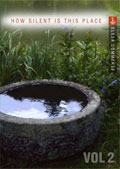
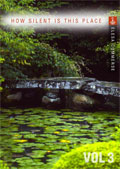 Volume 1 begins with the “OM” mantra, while Volume 3 ends with two English mantras. In between is everything from “Om Tryambakam” — the “Mahamrtyunjaya” mantra — to “Asato Ma,” with plenty of select kirtan chants in between. Elesa’s voice is the sole instrument, and the techniques for learning are quite clear. Each CD comes with a booklet that gives the Devanagari and English translations of the Sanskrit as well as musical notation.
Volume 1 begins with the “OM” mantra, while Volume 3 ends with two English mantras. In between is everything from “Om Tryambakam” — the “Mahamrtyunjaya” mantra — to “Asato Ma,” with plenty of select kirtan chants in between. Elesa’s voice is the sole instrument, and the techniques for learning are quite clear. Each CD comes with a booklet that gives the Devanagari and English translations of the Sanskrit as well as musical notation.
I love this collection for so many reasons. It is not a passive experience—it demands that one participate. I love the soft soulfulness of Elesa’s voice. The teaching allows us to reach into our hearts and begin to find ways to undo the hardness surrounding that special place. And I love the mantras themselves. Mantras are special magical seeds of sound. They blossom more and more as we begin this simple exploration of call and response chanting. Elesa is part of the core faculty at Chicago’s Moksha Yoga Center. For more information on her workshops, visit thedeepcalm.com.
Meditation and Yoga CDs by Local Yogis
by Sharon Steffensen
Editor, Yoga Chicago
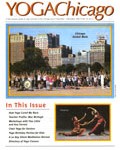
As a holiday gift for your yoga friends, why not buy local and purchase a CD recorded by one of Chicago’s talented teachers of yoga and meditation.
Elesa Commerse, a gifted meditation teacher, demystifies meditation for the modern practitioner in her CD, Sit Comfortably. She gives an overview of meditation, provides basic instruction, leads a guided meditation and invites you to select one of six tracks for a silent meditation of 5, 10, 15, 20, 25, or 30 minutes. Each track ends with a single strike of a mindfulness bell.
Elesa offers ongoing meditation classes at Moksha Yoga Center in Chicago, Generations Yoga in Wilmette, the Northwestern Memorial Hospital Wellness Institute, Mercy Hospital and Swedish Covenant Hospital’s Galter Life Center.
She is currently working with master teachers Tias and Surya Little as the Director of Wisdom Training for their highly regarded yoga teacher training program in Santa Fe, New Mexico, and is part of the core faculty for the Moksha Yoga teacher training program in Chicago.
Elesa’s teachers include the Ven. Thich Nhat Hanh, Sakyong Mipham Rinpoche, don Miguel Ruiz, Goswami Kriyananda, Donna Farhi and others.
Elesa is also the creator and facilitator of the critically acclaimed self-development workshop, Living Your Legacy (livingyourlegacy.com). To order her CD on meditation or her dharma talk, Looking Deeply into Love, first given at the Upaya Zen Center in Santa Fe, call Elesa at 773.777.7754, or through her website, thedeepcalm.com.
The CDs may also be purchased at Transitions Bookplace, Moksha Yoga, Generations Yoga, Women and Children First and The Temple of Kriya Yoga.
The article below about the benefits of meditation appeared in the May 29, 2006 issue of Jet Magazine.
The Benefits of Meditation
By Jet Associate Editor Marti Parham

It is a fact that stress is something that is felt by both the young and the old. Experts believe that one of the best ways to overcome the emotional, mental and sometimes even physical strain is by practicing the ancient art of meditation.